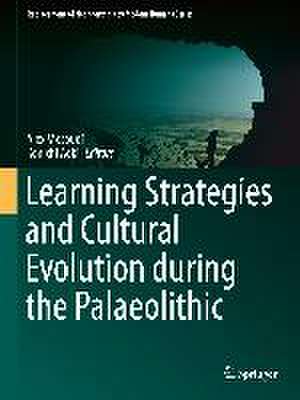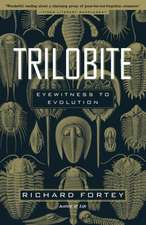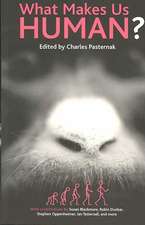Learning Strategies and Cultural Evolution during the Palaeolithic: Replacement of Neanderthals by Modern Humans Series
Editat de Alex Mesoudi, Kenichi Aokien Limba Engleză Hardback – 18 mai 2015
| Toate formatele și edițiile | Preț | Express |
|---|---|---|
| Paperback (1) | 369.57 lei 38-44 zile | |
| Springer – noi 2016 | 369.57 lei 38-44 zile | |
| Hardback (1) | 405.06 lei 3-5 săpt. | |
| Springer – 18 mai 2015 | 405.06 lei 3-5 săpt. |
Preț: 405.06 lei
Nou
Puncte Express: 608
Preț estimativ în valută:
77.53€ • 81.46$ • 65.16£
77.53€ • 81.46$ • 65.16£
Carte disponibilă
Livrare economică 19 februarie-05 martie
Preluare comenzi: 021 569.72.76
Specificații
ISBN-13: 9784431553625
ISBN-10: 4431553622
Pagini: 166
Ilustrații: X, 169 p. 55 illus., 28 illus. in color.
Dimensiuni: 210 x 279 x 15 mm
Greutate: 0.82 kg
Ediția:2015
Editura: Springer
Colecția Springer
Seria Replacement of Neanderthals by Modern Humans Series
Locul publicării:Tokyo, Japan
ISBN-10: 4431553622
Pagini: 166
Ilustrații: X, 169 p. 55 illus., 28 illus. in color.
Dimensiuni: 210 x 279 x 15 mm
Greutate: 0.82 kg
Ediția:2015
Editura: Springer
Colecția Springer
Seria Replacement of Neanderthals by Modern Humans Series
Locul publicării:Tokyo, Japan
Public țintă
ResearchCuprins
Introduction.- Experimental Studies of Cumulative Culture in Modern Humans: What are the Requirements of the Ratchet.- Factors Limiting the Number of Independent Cultural Traits That Can Be Maintained in a Population.- Inferring Learning Strategies from Cultural Frequency Data.- The Replacement of Neanderthals by Modern Humans and the Diversity in Cultural Transition Patterns: a Theoretical Perspective.- Simulating Geographical Variation in Material Culture: Were Early Modern Humans in Europe Ethnically Structured?.- “Learning in the Acheulean: Experimental Insights Using Handaxe Form as a ‘Model Organism’.- Behavioral Modernity and the Cultural Transmission of Structured Information: The Semantic Axelrod Model.- Evolution of Culturally Transmitted Teaching Behavior.- Transmission of Cultural Variants in the North American Paleolithic.- Mobility and Cultural Diversity in Central-Place Foragers: Implications for the Emergence of Modern Human Behavior.
Notă biografică
Alex Mesoudi is Reader in Anthropology at Durham University, UK. He conducts research into human cultural evolution and social learning. He uses a combination of lab experiments and theoretical models to explore the individual-level processes – who copies what, from whom and when – that underlie broad patterns of cultural change. He has authored over 40 peer-reviewed journal articles and book chapters and one previous book entitled “Cultural Evolution: How Darwinian Theory Can Explain Human Culture and Synthesize the Social Sciences” (University of Chicago Press, 2011).
Kenichi Aoki is Visiting Professor at Meiji University and Emeritus Professor at the University of Tokyo. He currently conducts theoretical research on cultural evolution and on the genetic evolution of learning strategies. He has also authored theoretical articles on group selection, gene-culture coevolution and mate choice. He is coeditor of two volumes focusing on the Neanderthal-modern human problem, “Neanderthals and Modern Humans in Western Asia” (Plenum Press, 1998) and “Dynamics of Learning in Neanderthals and Modern Humans Volume 1 Cultural Perspectives” (Springer 2013).
Kenichi Aoki is Visiting Professor at Meiji University and Emeritus Professor at the University of Tokyo. He currently conducts theoretical research on cultural evolution and on the genetic evolution of learning strategies. He has also authored theoretical articles on group selection, gene-culture coevolution and mate choice. He is coeditor of two volumes focusing on the Neanderthal-modern human problem, “Neanderthals and Modern Humans in Western Asia” (Plenum Press, 1998) and “Dynamics of Learning in Neanderthals and Modern Humans Volume 1 Cultural Perspectives” (Springer 2013).
Textul de pe ultima copertă
This volume is motivated by the desire to explain why Neanderthals were replaced by modern humans, in terms of cultural differences between the two (sub-)species. It provides up-to-date coverage on the theory of cultural evolution as is being used by anthropologists, archaeologists, biologists, and psychologists to decipher hominin cultural change and diversity during the Palaeolithic. The contributing authors are directly involved in this effort, and the material presented includes novel approaches and findings. Chapters explain how learning strategies in combination with social and demographic factors (e.g., population size and mobility patterns) predict cultural evolution in a world without the printing press, television, or the Internet. Also addressed is the inverse problem of how learning strategies may be inferred from actual trajectories of cultural change, for example as seen in the North American Palaeolithic. Mathematics and statistics, a sometimes necessary part of theory,are explained in elementary terms where they appear, with details relegated to appendices. Full citations of the relevant literature will help the reader to further pursue any topic of interest.
Caracteristici
Explains how Palaeolithic cultures evolved Suggests how cultural differences between hominin species contributed to replacement Presents novel approaches and findings in a form accessible to advanced graduate students Integrates concepts and methods from multiple traditional disciplines, including anthropology, archaeology, population biology and experimental psychology























